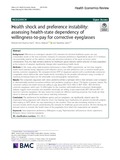Health shock and preference instability: Assessing health-state dependency of willingness-to-pay for corrective eyeglasses
Citation
Islam, M. N., Rabbani, A., & Sarker, M. (2019). Health shock and preference instability: Assessing health-state dependency of willingness-to-pay for corrective eyeglasses. Health Economics Review, 9(1) doi:10.1186/s13561-019-0249-3Abstract
Background: Differences in contingent valuation (CV) estimates for identical healthcare goods can cast
considerable doubt on the true economic measures of consumer preferences. Hypothetical nature of CV methods
can potentially depend on the salience, context and perceived relevance of the good or service under
consideration. Thus, the high demand elasticity for healthcare goods warrants careful selection of study population
as the contexts of valuation significantly changes after experiencing health shock.
Methods: In this study, using triple-bounded dichotomous choice (TBDC) experiments, we test how negative
health shock (namely, being diagnosed with refractive errors), can alter preference over a common health good
(namely, corrective eyeglasses). We compared elicited WTP of diagnosed patients with a synthetically constructed
comparable cohort without the same health shock, controlling for the possible self-selection using a number of
matching techniques based on the observable socio-demographic characteristics.
Results: The consumers diagnosed with vision problems exhibit a rightward shift in their demand curve compared
to observationally identical consumers without such problems resulting in about 17% higher consumer surplus. The
consumers without the health shock are willing to pay about BDT 762.4 [95% CI: BDT 709.9 - BDT 814.9] for
corrective eyeglasses, which gets 15–30% higher for the matched with-health-shock consumers. Multivariable
analyses suggest more educated and wealthier individuals are willing to pay respectively BDT 208 and BDT 119
more for corrective eyeglasses. We have tested the models for different matching protocols. Our results are fairly
robust to alternate specifications and various matching techniques.
Conclusion: The preferences for healthcare goods, such as eyeglasses, can significantly depend upon the
respondent being diagnosed with refractive errors. Our findings have implications for general cost-benefit analyses
often relying on WTP, which can vary depending on the contexts. There are also increasing interests in cost
recovery models, which require understanding the demand for healthcare goods and services. We find eliciting the
demand needs to consider the health status of the population from which the respondents are sampled.

